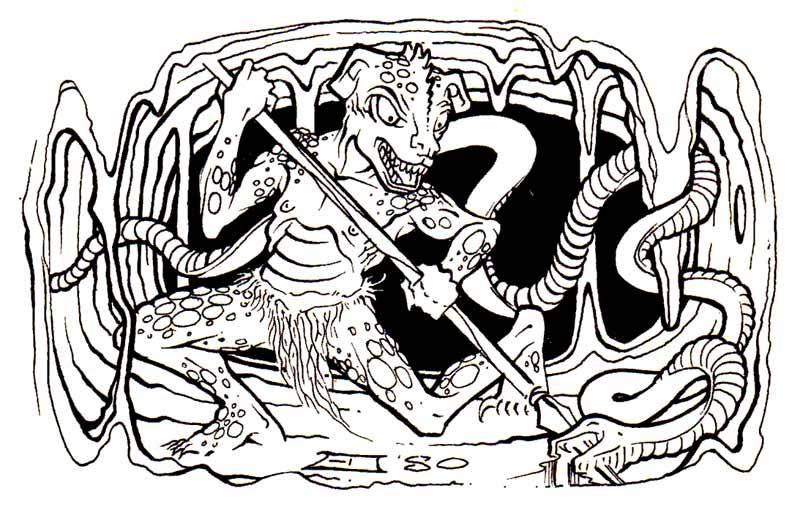The Subtle Fun of No Bonuses and the Butter Battle Book of D&D


I was running the adventure Danger in the Air! written by Michael Curtis at SIMCON 46 in Rochester, NY this past weekend. It is a funnel for the Dungeon Crawl Classics RPG and one of my favorite adventures.
The party was stumbling into monsters and traps as they explored inside a bizarre organism. They were making guesses about what’s dangerous and taking risks. As a 0-level funnel, the player characters usually have between 1 and 5 hit points. Each player began with 4 randomly generated PCs. Most of monsters did 1d4 or 1d6 damage per successful attack. No damage bonuses.
When a PC was hit by an attack, everyone held their breath and the player visibly prepared themselves to accept their character’s death. But then I rolled a 1 on the monster’s damage die. A PC with 2 HP survived! Players were jumping up. They were high fiving. The character fought on with their 1 remaining HP in good spirits. They have another chance to navigate this alien environment and maybe even learn how to avoid the particular danger that almost killed their PC. They might even find a way to heal a few hit points.
Sometimes a PC with 3 HP ends up surviving two attacks or traps like that, each one dealing just 1 damage as improbable as that is. Two near death experiences! They were having a blast.
It helps that I rolled the damage dice in front of the players, as the DCC RPG recommends. They knew I wasn’t fudging the dice, keeping them alive with plot armor.
No bonuses
The above scenes couldn’t have played out the same way if the monsters or traps had bonuses to their damage dice. If a monster’s dagger deals 1d4+2 damage, then it makes no difference whether the PC has 1 hit point or 3 hit points. They will automatically die if hit. The suspense and possible relief are accordingly less. The bigger the the bonus to the damage die, the fewer times that suspense and relief can occur.
This form of suspense is in addition to that over whether an attack will hit. But as long as we have separate attack and damage rolls, why not have suspense for both? With larger bonuses to damage dice, the greater the feeling of inevitability is, which can lead to despair, and I suspect, subtle frustration. The number of attacks necessary for the target to be slain is also less variable.
Similar dynamics suspense and relief have played out in my Old-School Essentials games. Monsters in OSE and other retroclones also rarely have damage bonuses. NPCs sometimes have damage bonuses granted by ability scores or magical weapons. Spellcasters can have bonuses to the damage dice of magic missile. That makes these opponents fearsome.
I remember when a party went up against a lich in one OSE game. It cast magic missile multiple times as a high HD spellcaster. Combined with the unerring nature of magic missiles and the bonus to their damage dice, this created the terrifying inevitability of doom. But that was exceptional and memorable and forced the players to make hard choices.
Most monsters are best run with no bonus to damage dice. For similar reasons, when a monster deals high amounts of damage, it’s best if their attack deals a single die of damage (e.g. 1d8 is preferable to 2d4). When bonuses are used, they should be kept small (+1 or +2). This way you can maximize the excitement of combat.
Bonuses to monsters’ damage dice became common with 3rd edition and I feel that was a mistake.
Bonuses for players
I don’t feel as strongly about bonuses for player characters. While I generally prefer symmetrical mechanics, mechanics that apply equally to PCs and NPCs, because they promote verisimilitude, I don’t think high bonuses negatively impact player experience.
D&D’s Butter Battle Book: Hit point and damage inflation
My favorite Dr. Seuss book is his Cold War satire The Butter Battle Book. If you haven’t read it or watched Ralph Bakshi’s cartoon adaptation, the premise is that the Yooks and Zooks realize they eat their bread with the butter on different sides. One eats it butter side up and the other butter side down. That sparks a cycle of escalating military armament between the two sides. When one builds a new weapon, the other tries to out do them and the cycle repeats. Just read or watch it.
In D&D the war is between the player characters and the NPCs and monsters. And, most simply, the escalation is of their hit points and of the damage each can deal the other. But other changes to the rules can contribute to this battle as well, such as forgiving dying rules, feats, and the asymmetric presence of saving throw proficiencies.
A new edition makes a change to increase the survivability of players. Then encounters becomes less challenging. Then the developers release an update, either a new edition, a new iteration of an edition, or just new monster books and monster design guidelines, increasing the threat and survivability of monsters. Then the cycle repeats with player characters gaining some new advantage.
Hit point inflation
Over the editions, hit dice have grown. The hit dice of the wizard has gone from d4 to d6. The rogue has gone from d4 to d8. Warriors have gone from d8 to d10. Also, starting with 3rd edition the ability scores needed to gain bonus hit points has decreased. And ability score generation methods have made it easier, or at least more guaranteed, to get those bonuses. Hit points at level 1 went from a die roll to the average to the maximum of a theoretical die roll. Hit points from leveling up went from a die roll to, in many groups, the average of the die roll rounded up. And hit point gain used to slow down dramatically at high levels. Now it keeps apace from level 1 to 20. Ability score increases after level 1 are now common so its easier to increase the Constitution bonus to hit dice. The toughness feat introduced in 3rd edition increased hit points for some characters. Species and class features in 5th edition often increase hit points further. Furthermore, the prevalence of healing has increased. Healing from natural rest has gone from 1 HP per day or 1d3 HP per 24 hours of rest to healing all hit points with just 8 hours of rest. More classes gain healing spells. 2024 D&D has doubled the dice of most healing spells. House rules also often increase PC hit points.
At the same time, monster hit points have also increased dramatically. An adult red dragon has gone from an average of 45 hit points in B/X D&D to 256 hit points in 2024 D&D. A goblin gone from 3 HP in B/X to 10 HP in the 2024 edition.
Damage inflation
Damage has gone from a short bow dealing 1d6 damage in B/X (no bonus from the Dexterity modifier) to 1d6+DEX mod in editions of the last 25 years. Backstab went from something challenging (and especially reward) to set up through clever play and luck to to so-called “sneak” attack damage being all but guaranteed in 4th and 5th edition. Many classes, feats, and spells grant large damage bonuses.
To keep pace with rising hit points, designers include higher bonuses to damage dice and add damage dice. An attack’s maximum damage not only goes up but so does its minimum damage.
The 2024 D&D increased the attack and damage bonuses as well as hit points of many monsters over those in the 2014 books. This is the latest corrective. But its a corrective to an issue of the publisher’s own creation. And it happened at the same time that baseline power of most PCs increased, so its hard to say what the result will be.
The result
The importance of a single hit point goes down like the value of currency with a normal rate of inflation. When will the cycle end? Or even reverse, like a government declaring that all $10 bills are now worth $1 and all $100 bills are now worth $10? The arithmetic becomes simpler at least.
While you could argue that the parallel increases in hit points and damage are proportionate that they still create the suspenseful effect described above just as effectively, that’s not what I’ve observed. Instead, combats can have a feeling of inevitability rather than suspense to them, whether the PCs are victorious or not.
D&D’s inflationary spiral won’t lead to Armageddon but it is futile.



